The barefooted have already tucked up all the sagum’s edges. Pressing on the sidewalks of via Tharros they created the narrow passage that Efisio Canu crosses on the run, as if born and pushed by the immaculate crowd. Waiting for him where the furrow leads into the open road the second bearer of the banner, greeted by the applause of the onlookers, of those facing out doors and balconies. He looks around for a few moments, looks in the faces for confirmation. He receives it, bends his torso forward and launches himself into the bright morning, immersed in the din of fireworks, as if leading the mad assault of an ancient infantry. The first "muda", the quartet in charge of carrying the statue of the saint, runs after him. Then other nine hundred follow, a white compact mass progressively induced to the collective movement: "Long live San Salvatore!", one calls. "Hurray!", all the others respond, parading and vanishing in the asphalt that leaves the borders of Cabras. The little Salvatore looks around, dazed, closed in a tiny sagum and lying on the stroller, while his father runs. It will be one-year-old, tomorrow. "It's too big an emotion, you can't explain", Monserrata Spanu says on the doorstep, his voice choked and his eyes turned to the runners, now invisible
"After forty-two races this year I wasn’t going to participate. But my nephew died in a car accident, he was the one who pushed me", explained Canu in the churchyard of Santa Maria, half an hour before triggering the run. "We make it for tradition, for those who no longer exist", adds his son Giuseppe, a twelve-year-old at his fourth experience. "I made a promise. For who? You don’t say that". "I do it for a person who died". "I do it for the people of Cabras. Trained? More or less, I started in mid-August ”, say Niccolò, Alessandro and Mauro, fourteen, fifteen and eighteen, waiting on the church’s stairs. In July it was already possible to see the future participants crossing the streets of the town barefoot, to go and have coffee with the first lights of the day. Or run in the dirt roads of the pine forest, enjoying the cool of the evening in the strip of land that separates the sea and the thousand pond’s rivulets, to improve respiration and thicken the calluses. Inside the church the mass is ending, the barefooted in the center and the faithful on the sides, as on the street.
It all started in the days of harvest, five hundred years ago, with the Saracen landing and promising looting at dawn. San Salvatore di Sinis was a small village of farmers and fishermen resting on the shores of the pond of Cabras. Not far away are the stones of the ancient city of Tharros and the Nuragic site that would have revealed the giants of Mont'e Prama many centuries later. Shores, these, where men seem to have lived since ever. At the center of S. Salvatore an ancient hypogeum, a sacred well that for centuries has hosted the pagan worship of waters and Punic, Greek, Roman rites and inscriptions and Koranic verses. Syncretism faded over time, contained and replaced in the Middle Ages by the walls of the small church dedicated to S. Salvatore. Too small in the number to resist, the inhabitants of the village rescued the simulacrum of the patron saint of Sinis, linking dry branches to the bare feet with which to raise a huge cloud of dust, fiction of a powerful army. Not even the world wars have been able to interrupt the ancient procession, the inverted miracle of the saint saved by the believers.
Thus the barefooted have kept running for half a millennium. They stomp the asphalt and the stony dirt surrounding the pond, they advance into the countryside, a long white swarm between the turned over earth, the fields emptied by the wheat and those parched by the summer. Fourteen priors lead as many groups, each composed of sixty/ seventy runners, divided into "mudas" of three, four or five. Seven kilometers to return to San Salvatore, where the crowd from Cabras followed to welcome them with more applause and roars, the respect due to the heirs of a heroic escape. "The heat of recent months has made the asphalt grainy. It was San Salvatore who supported me" says Andrea, smiling despite the sagum glued to his skin and his feet battered to blood. They all huddle around the shrine that protects the statue, they touch
the glass, they mark themselves. There is also the mayor Andrea Abis: “The race of the barefooted is one of the most important appointments of the Cabrarese community. A moment of religious faith and of people, of history and identity". Exhausted the runners follow the statue in the few meters that separate it from the small church, accompanying it with the "coggius", the traditional songs dedicated to San Salvatore.
In the early hours of the afternoon the sky fills with dark clouds. The Gulf of Oristano is a chase of thunder and lightning. In San Salvatore the party moved into the houses. From the doors wide open on the street one can see long tables laden with sweets and wine, hear modest chatter or crass laughter. The few tourists venture out among the puddles covered by the umbrellas, they scrutinize the facades of the "cumbessias", the humble houses of the 17th century that were the scene for so many western movies in the 60's and 70's. "The rain did not help us this year, but the race and the religious services, the most important things, went well, and we are grateful for this" says Andrea Scintu, president of the celebration's organizing committee. The house that hosts the members, which also operates as an essential bar, is an endless stream of greetings and wishes. "The celebration is so felt among the population because it comes from the heart" is the summary, moved, of his wife Giuseppina Trogu. "The town is united these days, even though the long preparatory work begins in January and involves many people", she adds. Religious sentiment intertwines with popular mysticism, but for those who gathered in Cabras as for those who attend here, clearly expressed or stuck in the throat as a cry, it always seems to converge in a place: the dark depth of the centuries from which it emerges , every year, a white swarm of men, the escape and the trick that created a community

The Island made of mussels in Corru Mannu's pond began to be populated by birds
Little tern, common tern, sandwich tern, rosy gull and black-winged stilt are some of the bird species that have found a home in Corru Mannu in recent weeks. Thanks to…

Sardinian Wetlands, the best way to protect them is "to manage them"
Cagliari, 04.02.2023 – Le zone umide sono ecosistemi acquatici sempre più rilevanti, conoscerli meglio è il primo passo per tutelarli, ma non è tutto. “Serve uno strumento di gestione” per…

The II D from Terralba Institute visited the Old Tower of Marceddì as prize for Terre d'Acqua school contest 2022
Learning about the role of these precious and very important ecosystems, as well as the specificities of the large wetland area of Oristano. In recent days we have accompanied the…

Maristanis was showcased at the Ramsar COP 14 on wetlands during a side event
The 14th meeting of the Ramsar Wetlands Conference (COP14) was held in Geneva from 5 to 13 November 2022, simultaneously also in Wuhan, China. At the International Conference Center in Geneva (CICG) all…

Learning from the Maristanis's model in the ENSERES's visit exchange
Two days to study an integrated management model of marine-coastal systems, two days to strengthen ties and develop new strategies for a sustainable future of the Mediterranean. The Italian stage…

A step forward for the Maristanis project, towards the Regional Park of wetlands in Sardinia
The Municipal Council of Oristano, on the proposal of the Councilor for the Environment Maria Bonaria Zedda, has launched the participatory process and the preparatory actions necessary for the establishment…

Evaluating ecosystem services by the TESSA Methodology in Arborea
How to understand the effects on natural capitals and actual and potential state changes of individual sites important in promoting decisions to support both biodiversity conservation and ecosystem service provision?

Terre D'Acqua 2022, the winners of the school contest within the Maristanis Project
With 87 works, of which 84 in the drawing category and 3 in the comics category, the MEDSEA Foundation's Terre D’Acqua 2022 Competition ends. The school contest took place from February…

The Sardinian farms met in Arborea under the sign of Sustainability
This is the year of relaunch for the La Fiera dell’agricoltura di Arborea (Agricultural Fair of Arborea), one of the most important thematic fairs in Sardinia that promotes the productive, agro and…

Maristanis in the news: Rai and Italia 1 dedicated ample space to the Maristanis Project
The Italian press gave ample space to the Maristanis project in recent months, the Oristanese wetlands and its most important project Maristanis were told in various national and local television reports on…

The winner of the World Wetlands Day in Sardinia 2022 Contest
With a picture taken in the Oristanese lagoons representing a group of flamingos and the sentence "They come / They come back / Sometimes they stop / Like nomads /…

Over 700 visitors for the World Wetlands Day Calendar
Over 700 visitors in the World Wetlands Day collective calendar, put together by the MEDSEA Foundation, as part of the Maristanis project last February, with the aim of promoting the precious…

The World Wetlands Day 2022 in Sardinia lasts a month, the events Calendar
As every year, the World Wetlands Day on the anniversary of the RAMSAR convention (of 1971, Feb. 2nd) calls and Sardinia, in particular the Oristanese area, replies within the Maristanis project that…

World Wetlands Day in Sardinia, from 2 to 27 February join the competition #WWDSardegna on Instagram
In the occasion of the World Wetlands Day which celebrates ponds and lagoons in the world next February 2, the MEDSEA foundation launches the contest on wetlands in Sardinia with the hashtag #WWDSardegna to…

MAVA Steering Committee in Provence: Sardinia was promoted with the Maristanis project
MEDSEA foundation, which has been carrying out the Maristanis project in the Oristano area in Sardinia since 2017, attended last week the yearly meeting of the MAVA steering committee. The session took place from 16 to 17 December 2021 in Châteauneuf-le-Rouge, in the Provence-Alpes-Côte d'Azur region, and gathered together the…

Terre d'Acqua, a wetlands school competition for students in the Oristanese
On February 2, the World Wetlands Day will be celebrated once again the Oristanese wetlands region. To recall the central role of wetlands in addressing climate and environmental crisis and to raise awareness of the importance of these basins especially in this west coast side…
- 1
- 2
- 3
- 4



